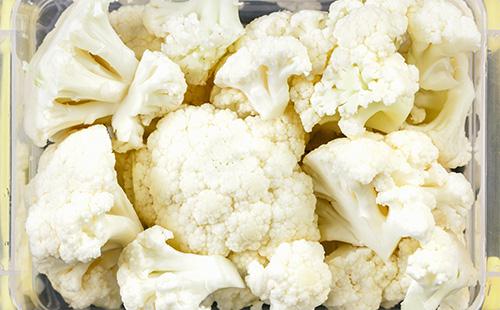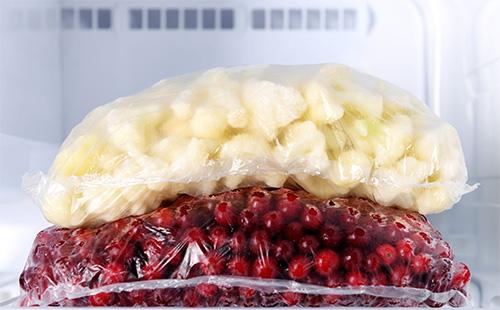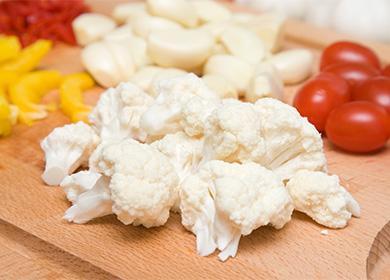Freezing is the most preferred way to preserve vegetables, fruits, berries for a long time. The method allows you to save most of the valuable substances and vitamins, attractive appearance and even taste of products: they practically do not differ from fresh ones.
About the benefits
The composition of cauliflower repeats the composition of its white-headed “sister”, only the concentration of valuable substances is different. So, in cauliflower, one and a half to two times more vegetable protein and two to three times more vitamin C. A useful vegetable also contains:
- cellulose - removes toxins from the body and toxic substances, stimulates the intestines;
- beta carotene - improves visual function;
- Vitamin B1 - stimulates brain activity, normalizes the digestive, cardiovascular system;
- Vitamin B2 - participates in the formation of red blood cells, is necessary for the functioning of the reproductive system;
- Vitamin B6 - promotes the absorption of lipids, improves memory, improves performance;
- vitamin PP - participates in tissue respiration, accelerates metabolism, activates the production of gastric juice;
- potassium - maintains water balance, normalizes heart rate;
- calcium - supports the work of the neuromuscular system, blood coagulation processes;
- phosphorus - regulates acid-base balance, participates in the brain, is necessary for the health of teeth and bones;
- iron - is part of hemoglobin, serves the nervous system.
Due to its balanced composition, cauliflower is a frequent guest on the table of supporters of proper nutrition and who want to find or maintain a slim figure. Doctors recommend a vegetable for diseases of the digestive system (but only in remission), they recommend including the product in the children's menu.
How to choose
If the task is to freeze cauliflower in the freezer, you need to give preference to weighty heads of medium size, covered with fresh green leaves. Here are three more things to consider.
- Colour. It can be white, yellowish, grayish, beige, greenish and even purple, depending on the variety and growing conditions. But there should not be dark spots and brown dots.
- Freshness. Heads of cabbage with traces of mold and rot should not be taken in the hope of cutting them, such stale fruits contain much less nutrients.
- Smell. The unpleasant "aroma" exuded by a head of cabbage should protect you from buying a vegetable.
How to freeze cauliflower for the winter
To preserve the attractive appearance of the vegetable, the substances contained in it and the “fresh” taste, it is necessary to familiarize yourself with some of the subtleties of freezing.
Basic rules
The frozen vegetable should be absolutely dry, otherwise instead of crumbly inflorescences, the harvest will be an unappetizing, sticky lump. Here are three more tricks to help freeze cauliflower.
- Freshness. The less time has passed from the moment of “harvesting” to freezing, the more nutrients will be able to be stored in the workpiece. That is why stale, spoiled fruits are not good.
- Isolation. Do not put vegetables on the freeze next to meat, fish and other odorous products.
- Portioning. Freeze cabbage, spreading into bags or containers in small volumes. Defrosting and repeated freezing negatively affects the taste, appearance and nutritional value of the vegetable.

Process description
Cauliflower is a solid vegetable that, unlike meaty and succulent foods, is considered easy to freeze. The procedure is carried out in four steps.
- Cleansing. Remove the upper leaves from the head, divide into inflorescences, put in a colander and wash thoroughly with warm running water.
- Blanching. A culinary method involving fast cooking and instant cooling. Immerse the inflorescences in boiling salted water, after two to three minutes, remove it with a slotted spoon and immediately cover it with ice water. This "therapy" allows you to remove oxidative enzymes that cause an unpleasant aftertaste of the workpiece.
- Drying. Put the workpiece in one layer on a flat dish or tray, dry.
- Freezing Arrange in containers or special bags and put in the freezer.
Cauliflower can be frozen whole without dividing into inflorescences. Small heads of cabbage are used for this, but they need to be cooked five minutes longer.
Blank for baby
A healthy vegetable is often introduced into the children's menu, especially in winter, when a growing body especially needs vitamin supplements. To freeze cauliflower to feed the baby, you need to follow the instructions described above. A significant difference - you need to cook the product two to three times longer.
If the cauliflower was frozen correctly, the workpiece can be used to make baby puree. To do this, the frozen vegetable is boiled until soft, then processed into pulp with a blender.
What then: recipes
Having frozen cabbage in the refrigerator, you can create countless tasty and healthy dishes: simple and more complex. You can throw inflorescences into boiling water, cook for several minutes and serve as a side dish to chicken or fish. Here are four more ideas for housewives who don’t know what to make from frozen cauliflower.
Breaded
- Boil in salted water for two to three minutes.
- Beat two eggs with three tablespoons of flour, salt to taste.
- Dip each inflorescence in batter and fry on all sides in a heated frying pan.
In creamy sauce
- Boil inflorescences in salted water for three minutes.
- Fry a quarter cup of flour to a brownish tint in 50 g of butter.
- Reduce the heat to a minimum, pour 320 ml of milk in a thin stream and, stirring constantly, wait until the composition thickens. To taste, add turmeric and salt.
- Grind 120 g of hard cheese with a coarse grater and mix into the sauce, continue stirring until the component is completely dissolved.
- Put cabbage on a baking dish with non-stick coating, add sauce and sprinkle with grated cheese.
- Place in the oven preheated to 170 ° C and bake until browned.

Soup
- Prepare 3 l of broth (chicken, meat or vegetable), salt to taste.
- Three raw potatoes and one carrot cut into cubes, chop the onion and dip the vegetables in a boiling broth.
- After 10-15 minutes, add cabbage (300 g), previously thawed at room temperature, to the soup divided into small inflorescences.
- Five minutes later, introduce the chopped tomato into strips.
- Cook for five to seven minutes, introduce bay leaf and one or two peas of allspice.
- After another five minutes, turn off the fire, let the soup stand for five to ten minutes, covering the pan with a lid.
Stew
- Thaw cabbage at room temperature, boil for two to three minutes in salted water.
- Cut carrots into circles, chop one onion, chop one or two medium-sized zucchini into cubes.
- In a heated frying pan, brown the cabbage for one to two minutes, then, folding the vegetable in a pan, sauté the carrots and onions in the same pan, then fry until the squash is soft.
- Put all the vegetables in a thick-walled pan, salt and simmer for 20 minutes on a quiet fire. You can not add water, as vegetables will give a sufficient amount of juice. But you can enter a small amount of liquid or broth.
- Five minutes before the readiness to introduce tomato cut into thin slices and chopped parsley and dill to taste.
Knowing how to freeze cauliflower for the winter, you can quickly stock up on a healthy product. A vegetable prepared in this way is stored for six months, then its nutritional and taste properties are lost. Therefore, "experienced" recommend indicating the date of freezing on the container or bag in order to monitor the quality of food consumed.
Other Soup Recipes
Cauliflower
Savoy cabbage
Dumplings soup
Lamb in a slow cooker

